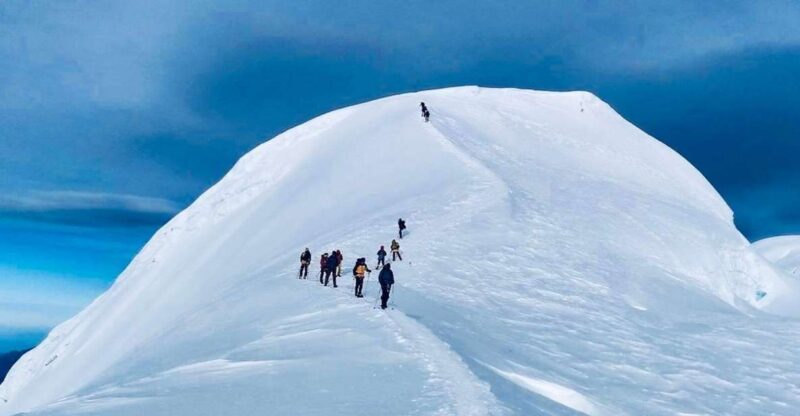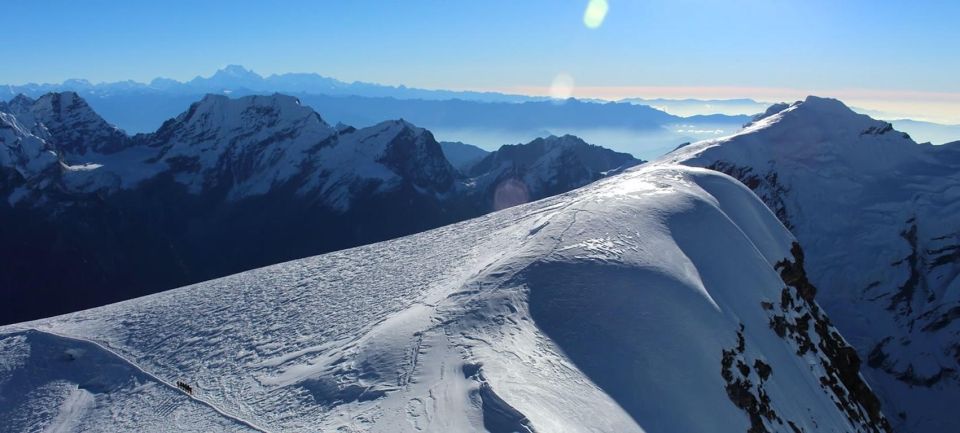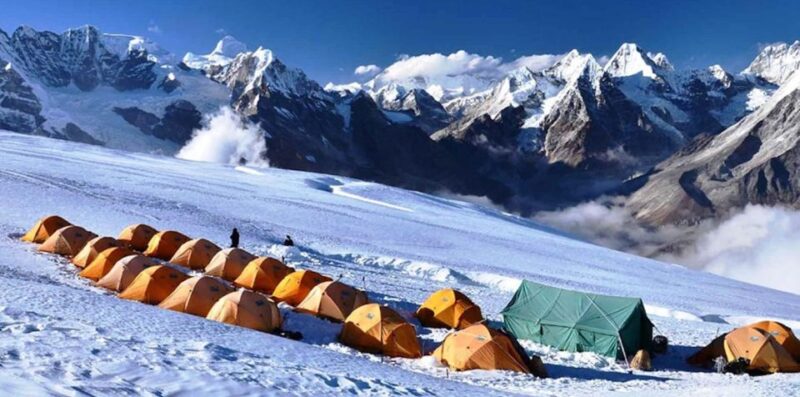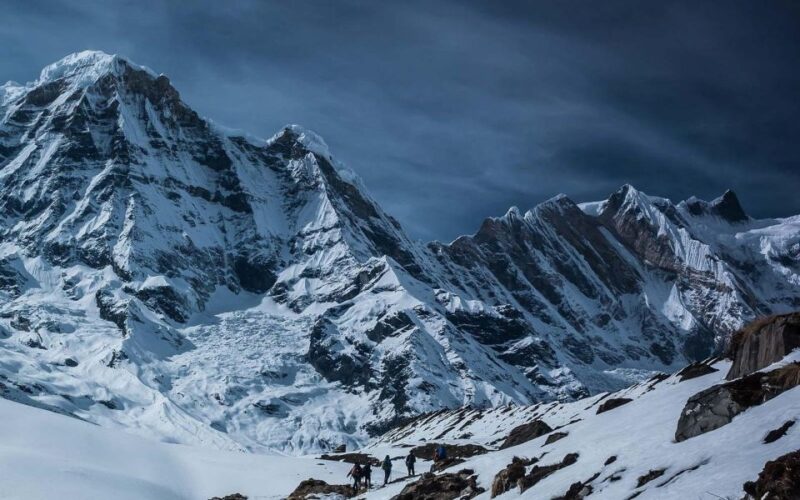Mera Peak, at 6,654 meters, stands as Nepal’s highest trekking peak, attracting adventurers eager for a Himalayan challenge. The typical 18-day trek offers not only stunning vistas but also rich cultural interactions with the Sherpa community. For those considering this journey, understanding the itinerary and preparation involved is crucial. As the trek demands both physical endurance and mental resilience, it’s essential to explore what lies ahead for climbers. What unique experiences and challenges await those who choose to ascend this majestic peak?
Key Points

- Mera Peak stands at 6,654 meters, making it the most climbed peak in the region, ideal for aspiring mountaineers.
- The trek typically lasts 18 days, incorporating acclimatization and exploration for a thorough experience.
- Costs start at $3,490.14 per person, covering permits, meals, and accommodation but excluding international airfare and insurance.
- The journey offers stunning landscapes, Sherpa cultural interactions, and breathtaking views of Everest and Lhotse.
- Safety is paramount; trekkers should stay hydrated, acclimatize gradually, and recognize altitude sickness symptoms.
Overview of Mera Peak

Mera Peak, located in Nepal, is renowned as the most climbed peak in the region, offering breathtaking views of five of the six highest mountains in the world.
With an elevation of 6,654 meters, it attracts adventurers seeking both challenge and stunning vistas. The trek to the summit typically lasts 18 days, allowing ample time for acclimatization and exploration.
The cost starts from $3,490.14 per person, which includes essential permits, meals, and accommodation. The journey provides a unique opportunity to experience the rich culture and hospitality of the Sherpa people, making it not just a climbing expedition but also a culture.
Mera Peak stands as a gateway for climbers looking to conquer the Himalayas.
You can also read our reviews of more tours and experiences in Lukla.
Trekking Experience

The trekking experience to Mera Peak immerses adventurers in the stunning landscapes of the remote Khumbu and Hinku valleys, where frozen waterfalls and lush forests create a breathtaking backdrop.
As trekkers navigate through this majestic terrain, they encounter small Sherpa villages, offering a glimpse of rich local culture and warm hospitality.
The trek involves glacier walking, requiring the use of crampons and an ice axe, yet it remains a non-technical climb, making it accessible for many.
Along the way, trekkers also witness awe-inspiring views of towering peaks, including Everest and Lhotse.
This journey not only challenges physical limits but also enriches the spirit, creating unforgettable memories amidst nature’s grandeur.
Detailed Itinerary

Embarking on an 18-day adventure, trekkers will follow a carefully crafted itinerary that balances acclimatization, exploration, and the exhilarating climb to Mera Peak. Each day is designed to optimize the experience and ensure safety, highlighting essential components:
-
Arrival and Briefing: The journey begins in Kathmandu with essential preparations.
-
Trekking to Paiya: A scenic flight to Lukla precedes a trek through lush landscapes.
-
Acclimatization Days: Trekkers spend crucial days adjusting to altitude, enhancing their chances for summit success.
-
Summit Push: After reaching Mera La, the excitement builds as climbers tackle Mera Peak.
With a mix of culture, stunning vistas, and strategic planning, this itinerary promises an unforgettable experience in the heart of the Himalayas.
Inclusions and Exclusions

Included in the trek are essential services such as airport transfers, all meals during the journey, and necessary permits for climbing Mera Peak and entering Sagarmatha National Park. Participants can look forward to a comprehensive experience that ensures their adventure is both enjoyable and secure.
| Inclusions | Exclusions | Emotional Impact |
|---|---|---|
| Airport transfers | International airfare | Excitement of embarking |
| All meals during trek | Nepal visa | Comfort of nourishment |
| Mera Peak climbing permit | Insurance | Safety concerns |
| Licensed Sherpa guide | Tips | Appreciation of service |
| Farewell dinner | Accommodation in Kathmandu | Connection with culture |
This careful mix of inclusions and exclusions highlights the essentials while setting realistic expectations for trekkers.
More Great Tours NearbyClimbing Preparation
Preparation for climbing Mera Peak involves a combination of physical training, gear selection, and understanding the unique challenges of high-altitude trekking. Climbers should focus on these key areas:
-
Physical Training: Incorporate cardio, strength, and endurance workouts at least three months prior to the trek.
-
Gear Selection: Invest in high-quality gear, including waterproof clothing, crampons, and an ice axe, to ensure safety and comfort.
-
Acclimatization: Gradually ascend to higher altitudes to allow the body to adapt and reduce the risk of altitude sickness.
-
Mental Preparation: Develop a positive mindset and learn stress management techniques to tackle the mental challenges of climbing.
Cultural Insights
Mera Peak offers climbers a unique opportunity to enjoy the rich Sherpa culture, characterized by warm hospitality, vibrant traditions, and breathtaking mountain views. Visitors can engage with local customs, witness traditional ceremonies, and savor authentic Sherpa cuisine. The connection between the Sherpa people and the majestic Himalayas adds a profound depth to the climbing experience.
| Aspect | Description | Significance |
|---|---|---|
| Hospitality | Warm welcomes and shared meals | Creates a sense of community |
| Festivals | Celebrations like Losar (New Year) | Showcases vibrant traditions |
| Local Cuisine | Dishes like dal bhat and momo | Provides insight into daily life |
This culture not only enriches the trek but also fosters mutual respect and understanding between climbers and the Sherpa community.
Safety and Health Tips
Climbers should prioritize their health and safety by staying hydrated, acclimatizing properly, and being aware of the signs of altitude sickness. To ensure a safe and enjoyable experience on Mera Peak, they can follow these essential tips:
-
Stay Hydrated: Drink plenty of water daily to combat dehydration.
-
Acclimatize Gradually: Ascend slowly and allow the body to adjust to altitude changes.
-
Recognize Symptoms: Be alert for signs of altitude sickness, like headaches, nausea, or dizziness.
-
Listen to Your Body: If feeling unwell, don’t hesitate to descend to a lower altitude.
Booking and Cancellation Policy
Booking a trek to Mera Peak involves straightforward procedures, ensuring participants can easily secure their adventure while enjoying a flexible cancellation policy.
To initiate the booking, trekkers typically need to complete a form and submit a deposit. The full payment is usually required a few weeks before departure.
The cancellation policy is particularly accommodating, allowing participants to cancel up to 24 hours in advance for a full refund. This flexibility provides peace of mind, especially with potential uncertainties in travel plans.
Plus, trekkers should review their specific tour operator’s terms, as policies may vary.
Frequently Asked Questions
What Is the Best Time to Climb Mera Peak?
The best time for climbing typically falls between late spring and early autumn. During these months, weather conditions stabilize, offering climbers clearer skies and milder temperatures, significantly enhancing the overall climbing experience and summit success.
Are There Age Restrictions for Climbing Mera Peak?
For climbing, age restrictions exist. Participants must be at least 18 years old, while those over 95 aren’t permitted. These guidelines ensure safety and suitability for the physical demands of the expedition.
How Physically Fit Do I Need to Be?
To climb successfully, one needs good cardiovascular fitness, strength, and endurance. Regular hiking, cardio workouts, and strength training prepare climbers for altitude challenges. It’s essential for enjoying the trek and ensuring safety throughout the journey.
What Should I Pack for the Trek?
For the trek, he should pack essential clothing layers, sturdy hiking boots, a warm sleeping bag, personal toiletries, a first-aid kit, and hydration supplies. Don’t forget trekking poles, snacks, and a reliable backpack!
Can I Hire Additional Porters During the Trek?
When trekking, travelers can hire additional porters to ease their load. It’s advisable to arrange this in advance, ensuring sufficient support throughout the journey. This allows for a more enjoyable and manageable trekking experience.
Recap
To sum it up, Mera Peak offers an unforgettable adventure for trekkers and climbers alike.
With its stunning landscapes, rich cultural experiences, and the thrill of reaching a high-altitude summit, this journey is one for the books.
Proper preparation and an understanding of the region’s unique challenges ensure a safe and enjoyable trek.
Whether you’re an experienced climber or a passionate hiker, Mera Peak invites you to explore the heart of the Himalayas and create lasting memories.
You can check availability for your dates here:More Tour Reviews in Lukla
Not for you? Here's more nearby things to do in Lukla we have reviewed
- Everest Heli Sightseeing Tour
- Mera peak trek
- Everest Base Camp Helicopter Landing Tour from TIA – 1 Day
- Everest Base Camp Trek – 6N/7D
- Nepal: Mera Peak Expedition with Trekking and Climbing
- Everest Scenic Mountain Flight (Review Exclusion Section)
- 16-Day Mera Peak Climbing Expedition
- 9 Best Tours In Lukla
- 24 Best Treks And Hiking Tours In Lukla
- 11 Best Helicopter Flights And Tours In Lukla
- Everest Base Camp Trek
- Kathmandu to Ramechhap Manthali Transfer – Sharing Vehicle
